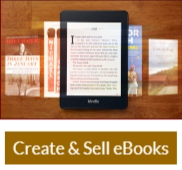How to Write Surprisingly: Your First User-Friendly e-book
By Watthana P.
Table of Contents
1. Introduction
Why do people write an e-book?
2. 10 great writing techniques that you can write a book and captivate your readers.
- 2.1. Anecdotes: give practical examples of what you are trying to explain.
- 2.2 Images are a powerful tool.
- 2.3 Note-boxes or sidebars are good for summarizing or providing additional information.
- 2.4 Write with a casual, conversational tone rather than a formal tone such as textbook diction.
- 2.5 Don’t write long sentences or paragraphs.
- 2.6 Using lists, both bulleted and numbered.
- 2.7 Use spacing of at least one and a half lines, and use text that is large enough to be easily read.
- 2.8 Choose a font that is easy to read and stick with that font family.
- 2.9 Add page numbers and a header to each page with your eBook title.
- 2.10 Be sure to check your spelling and grammar for correctness, and create an index and a bibliography.
3. Conclusion
Introduction
You can write surprisingly, your first user-friendly e-book if you use these great techniques in this post.
You are probably familiar with the term e-book.
Have you ever wondered why people are turning to e-books so widely these days?
Why do people write e-books?
People write e-books for various reasons.
Some of the key reasons people turn to writing e-books are:
1. To share knowledge:
E-books are a great way to share your knowledge with other interested parties on social networks that are becoming more and more popular these days. They can be used to teach people about a particular topic or skill.
via GIPHY
2. To make money:
E-books can be sold online, which makes them a great way to make money.
via GIPHY
3. To promote products or services of your business:
You can also use e-books to promote other products or services of your business without incurring any additional costs by devoting the time you have to write the book and adding your content.
4. To establish authority:
Writing an e-book can build your credibility and reputation in your professional field.
via GIPHY
5. To reach a wider audience:
E-books can be distributed easily and inexpensively, which makes them a great way to reach a wider audience. They can be shared on social media, blogs, and other websites.
6. To express creativity:
E-books can be used to express creativity. They can be used to tell stories, share poetry, or showcase artwork.
via GIPHY
7. To save money: E-books are often less expensive to produce than traditional books.
Why are e-books often less expensive to produce than traditional books?
E-books are often less expensive to produce than traditional books due to several reasons.
Firstly, e-books do not require paper, ink, or the process of printing and binding, which results in significant cost savings for the publisher.
Secondly, when creating an e-book, you can edit and format the manuscript yourself for free or at a lower cost than creating a book in the traditional format.
Lastly, e-books can be distributed and sold online, which eliminates the need for physical storage and shipping costs.
In contrast, traditional books require more materials and labor, such as paper, ink, printing, and binding, which makes them more expensive to produce. Additionally, traditional books require physical storage and shipping, which adds to the cost.
10 great writing techniques that you can write a book and captivate your readers.
No matter what your reasons are, there are some basic principles to consider that will make the final book more professional.
From now on, you will know how to write an engaging and interesting book.
via GIPHY
Most importantly, you want them to read your entire e-book, right?
And of course, you want them to come back and read your writing if you’re building an online business.
You need to find a way to make your writing engaging. Often anecdotes, testimonials, anecdotes, pictures, graphs, tips, and tricks It will make the reader turn the pages to read your book.
You can write surprisingly, your first user-friendly e-book using these great techniques below.
Here are some great techniques you can use.
2.1 Anecdotes: give practical examples of what you are trying to explain.
This gives readers confidence that what you are saying works. They are also a great way of explaining complicated topics.
via GIPHY
2.2 Images are a powerful tool.
Image can make a topic clearer and will remain in the reader’s mind longer than 5,000 words of text.
Images also divide the eBook into sections and guide readers to the sections that interest them.
via GIPHY
2.3 Note-boxes or sidebars are also good for summarizing a point or providing additional information. Like images, they break up the text and make the reading experience more enjoyable.
Sidebars are useful for quick, accessible information, and they break up the density of the page.
via GIPHY
2.4 Write with a casual, conversational tone rather than a formal tone such as textbook diction.
Readers respond to the feeling that you are having a conversation with them.
This way, they feel that they are the only ones benefiting from your information, and that makes it more valuable to them.
via GIPHY
2.5 Don’t write long sentences or paragraphs because readers will find them difficult to understand and not interested in reading.
Most eBook readers tend to put them down and never pick them up again.
You should vary the length of paragraphs and sentences so that readers don’t get bored reading.
via GIPHY
Blocks of text of the same length will distract readers, but you might be lucky if they wake up before page 10!
Using images is one way to break up text so that it is easily understood by readers.
It’s possible that you can’t use images with every message, but there are other techniques you can use to grab your reader’s attention.
via GIPHY
2.6 Using lists, both bulleted and numbered.
A very powerful one is the use of numbered and bulleted lists.
Even with the most basic of word-processing programs, you can include different types of bullets and even use custom pictures as bullet icons.
These make your topic easier for the reader to absorb and also give them a mental break from blocks of text.
via GIPHY
2.7 Use spacing of at least one and a half lines, and use text that is large enough to be easily read on a mobile, smartphone, or tablet screen.
In eBooks that are read on the screen.
You need to give readers a break by using white space.
via GIPHY
In art classes, white space is often referred to as “negative space.”
The reader’s eyes need to rest in the soft white oasis you have created on your page. If your page is too dense. Readers will stop reading as soon as their eyes begin to ache.
You should use at least a line and a half of spacing and text large enough to be easily read on the screen but small enough to see the entire page on your computer, smartphone, or tablet screen.
You’ll have to experiment with this to find the right distance.
I recommend spacing the lines by one and a half or two lines.
Spacing lines too far apart makes it difficult for readers to follow where they are. While the distance is too close, it can be boring for the reader.
2.8 Choose a font that is easy to read and stick with that font family.
Using dozens of fonts will bore your readers before they even get past your intro.
Additionally, choose a font size that is proportional to the line spacing you use.
You can use a larger font (e.g., 14 points) with 1.5 line spacing, but 8 points will look strange.
You have to experiment with different combinations to find the one that works for you.
But remember, what looks good on screen may look terrible in print.
Think about how your readers are likely to read the final eBook (in most printed PDF eBooks, the idea of a paperless world is just a myth!)
2.9 Add page numbers and a header to each page with your eBook title.
Don’t forget to include the page number.
I’ve annoyed myself many times with the number of eBooks that don’t have page numbers.
Additionally, adding a title to the header is a great way to remind readers what they are reading and who wrote it.
Don’t make the header and footer too tight.
This should be used wisely to brand your eBook (your company name or web address if you sell online).
2.10 Be sure to check your spelling and grammar for correctness, and create an
index and a bibliography.
You are judged on little things, like correct punctuation.
So don’t spoil a good book. Messy with random semicolon throws, or string sentences with commas. (Also called “comma connection”)
You can also go somewhere like elance.com and ask someone to review it for you (for a fee).
It’s worth it to make your eBook look trustworthy.







